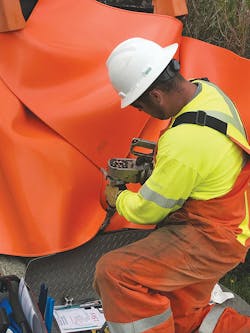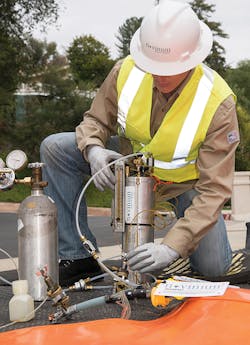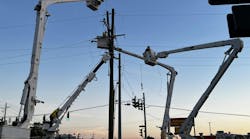Aging electrical cables were failing across residential neighborhoods in Ontario, Canada, leading to repeated power outages. To provide safe and reliable electricity, Veridian Connections explored the possibility of a cable rejuvenation program.
As the fifth-largest municipally owned electricity distributor in Ontario, Veridian delivers electricity to more than 121,000 residential and business customers in the province. The company, which was recently recognized again as one of Canada’s greenest employers, wanted to find a sustainable solution to the growing problem of frequent power outages on aging underground cables.
Getting Started
Veridian first learned of the process of electrical cable rejuvenation at a conference at neighboring utility Toronto Hydro. Based on the information provided during the presentation, the company performed a detailed economic analysis of the costs and determined the failing electrical cable in the Veridian system could be rejuvenated at one-third the cost of replacing those same cables. The significant cost savings encouraged the company to look more closely at this technology for one key reason — the savings would allow the utility to fix three times as much cable for the same cost as replacement.
However, there was internal skepticism over whether this technology really worked. To get validation of the cable rejuvenation process, Veridian reached out to several utilities that were using cable rejuvenation.
After receiving positive feedback from several other utilities, Veridian decided to try cable rejuvenation. Veridian had been recording and tracking electrical cable failures for 10 years, and one residential subdivision had been experiencing multiple failures every single year.
When Novinium, a cable rejuvenation provider, asked Veridian to choose its worst area as a test project, the Shadybrook subdivision in Pickering, Ontario, immediately came to mind. Because this subdivision had the highest concentration of failures, Veridian knew that if cable rejuvenation worked in this area, it would work anywhere in the system.
Injecting Cable
The process of cable rejuvenation begins with isolating, testing and grounding the cable. Technicians use a TDR device to check every segment for splices, neutral corrosion and length. They then pinpoint splices by using a radio-frequency locator and a measuring wheel.
Once this process is complete, if splices are detected, the workers must dig a pit to expose and remove the old splices. They must then use a portable radial press to install new injection adaptors and a splice connector. Next, they verify the craftwork with a template for each termination and position the injection tools accordingly. Initially the process includes injecting each subsegment at a moderate pressure. For example, a 100-m (328-ft) segment typically takes less than an hour to inject. Special fittings are attached to each cable end, allowing fluid to flow through the innermost stranded portion of the cable. The fluid permeates outward into the deteriorated insulation and begins immediately to reverse the damage done by years of water tree degradation. The fluid migrates into the conductor shield and insulation, modifying the insulation’s chemistry and extending cable life. The electric cables return to their full dielectric strength within as little as seven days from the date of the procedure.
Rejuvenation involves injection of alkoxysilane fluid into the interstices between the cable conductor strands. The low viscosity monomer flows down the cable strands and diffuses radially through the conductor semicon to reach the water tree region in the cable insulation. A pressure and flow test is used to ensure sufficient fluid flow through cable strands as well as to test the capability of existing joints withstanding the injection pressure.
Once the actual injection is complete, the equipment is removed, and the process is completed by installing standard elbows at each end. The final step is the re-energizing of the cable, restoring of the work area and moving on to the next segment of cable to be injected. This process takes a single visit with an average of four hours.
After cable is injected, a post-screening test is also performed to ensure all the craftwork is performed correctly and that no damage of cable insulation is caused during the switching process. This allows customers to optimize their reliability budget by treating all cables that can be treated and replacing only those that cannot be effectively treated with the Cablecure process from Novinium.
Novinium’s Sustained Pressure Rejuvenation (SPR) rejuvenation process uses moderate pressure to greatly speed the distribution of the rejuvenation fluid into the insulation. The pressure used is well below the psi specified by cable manufactures. The full dielectric strength of the cable segment is restored within seven days.
The SPR injection process is used on clear runs and runs with blocked splices. If there is a blocked splice, the splice is excavated, and the injection is performed in both directions from the splice toward the terminations before the splice is replaced and the pit is restored. The speed of the SPR method makes large injection projects extremely fast, effective and manageable for utilities like Veridian.
Reviewing the Results
Novinium’s recommendation was to use the most advanced Cablecure 732 fluid, using the SPR process because it would restore the cable to full dielectric strength within seven days and comes with a 40-year warranty.
The test project in Shadybrook proved to be a success, and failure rates plummeted from multiple failures every year to near zero after cable rejuvenation. The test project convinced even those who had been skeptical that cable rejuvenation was a better, faster and more capital-efficient way to prevent faults than traditional cable replacement.
Since that first test project, Veridian has steadily expanded its investment and now regularly includes rejuvenation in its capital budget, injecting about 19 km (12 miles) each year to proactively upgrade entire subdivisions. Like many utilities, Veridian has a business goal of reducing its operations and maintenance budget, and Cablecure plays a key role. When a cable fails in service, the utility now injects it rather than just replacing it. Previously, the repair cost would have been charged to operations and maintenance, but now it goes into the capital budget.
"Community-owned utilities are looking for ways to enhance their infrastructure reliability and performance, while controlling expenses," says Jon Engman, CFO, Novinium. "It’s important that they talk to one another to share their experiences and strategies to ensure that they can continue to provide reliable electrical services as the appetite for electric consumption continues to expand."
Improving Reliability Scores
Before incorporating rejuvenation into its asset management program, Veridian’s overall system average interruption duration index (SAIDI) score reflected average outage durations of 18.21 hours per customer, but the utility has been able to decrease this drastically to 1.24 in 2016.
Similarly, Veridian’s system average interruption frequency index (SAIFI) has been reduced by more than half, from 2.8 average interruptions per customer in 2013 to just 1.29 in 2016. Another benefit of Veridian’s ongoing rejuvenation program is the ability to access detailed underground maps and technical specs, including neutral condition and splice locations for each segment, at any time through Novinium’s web-based online tool Knomentous. Veridian leverages the Knomentous tool frequently to plan other repairs and projects.
Veridian has been able to deliver this significant increase in performance while keeping customer rates low, and Veridian’s customers appreciate the decreased downtime and disruption. Electrical cable rejuvenation minimizes the impact on the neighborhoods by protecting boulevard plantings and eliminating the need for holes, which are dangerous for children and pets.
Prior to the rejuvenation program, electrical customers saw Veridian’s trucks on their street and inquired how long the power would be out. Now with the Novinium cable rejuvenation program in place Veridian customers hardly notice when work has been performed in their neighborhood.
The partnership has evolved to meet Veridian’s changing budget and business priorities. For example, Veridian’s capital dollars are being reserved for the construction of a new substation in 2018, so Novinium’s linemen remain on call to quickly address any faults that come up at Veridian.
"We send our linemen out on Saturdays in between other projects, and anyone who is working within 100 miles can pitch in if Veridian has a fault that needs attention," says Dean Stone, Novinium’s regional manager in Canada. "Most utilities can’t move that quickly, but Novinium can."
Looking to the Future
Veridian Connections must keep the lights on for its customers despite having a great deal of 1960s and 1970s vintage electrical cable, which has surpassed its intended 40-year life expectancy. The utility has more than 140 km (87 miles) of cable that hasn’t been injected yet, so the company still has a long way to go.
The company currently injects about 20 km (12 miles) per year, so it will take another seven years to complete, but by then, other newer areas will need to be addressed. Still, the company is making steps in the right direction to provide safe, reliable power through cable rejuvenation. ♦
Ed Johnston is a distribution engineer for Veridian. He has more than 30 years of experience, and during his career, he has worked in operations, engineering construction and maintenance. In his current role, he is focusing on asset management and planning for his utility.





